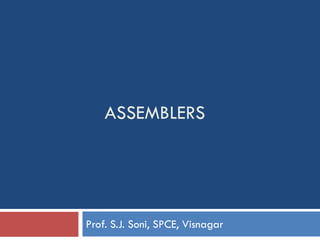assembler-ppt.pdf
•
0 gostou•90 visualizações
Assembler
Denunciar
Compartilhar
Denunciar
Compartilhar
Baixar para ler offline

Recomendados
Recomendados
Mais conteúdo relacionado
Mais procurados
Mais procurados (20)
Peephole optimization techniques in compiler design

Peephole optimization techniques in compiler design
Semelhante a assembler-ppt.pdf
Semelhante a assembler-ppt.pdf (20)
Último
Último (20)
Call Girls Alandi Call Me 7737669865 Budget Friendly No Advance Booking

Call Girls Alandi Call Me 7737669865 Budget Friendly No Advance Booking
FAIRSpectra - Enabling the FAIRification of Spectroscopy and Spectrometry

FAIRSpectra - Enabling the FAIRification of Spectroscopy and Spectrometry
High Profile 🔝 8250077686 📞 Call Girls Service in GTB Nagar🍑

High Profile 🔝 8250077686 📞 Call Girls Service in GTB Nagar🍑
pumpkin fruit fly, water melon fruit fly, cucumber fruit fly

pumpkin fruit fly, water melon fruit fly, cucumber fruit fly
Seismic Method Estimate velocity from seismic data.pptx

Seismic Method Estimate velocity from seismic data.pptx
Introduction,importance and scope of horticulture.pptx

Introduction,importance and scope of horticulture.pptx
Kochi ❤CALL GIRL 84099*07087 ❤CALL GIRLS IN Kochi ESCORT SERVICE❤CALL GIRL

Kochi ❤CALL GIRL 84099*07087 ❤CALL GIRLS IN Kochi ESCORT SERVICE❤CALL GIRL
Pulmonary drug delivery system M.pharm -2nd sem P'ceutics

Pulmonary drug delivery system M.pharm -2nd sem P'ceutics
SAMASTIPUR CALL GIRL 7857803690 LOW PRICE ESCORT SERVICE

SAMASTIPUR CALL GIRL 7857803690 LOW PRICE ESCORT SERVICE
9654467111 Call Girls In Raj Nagar Delhi Short 1500 Night 6000

9654467111 Call Girls In Raj Nagar Delhi Short 1500 Night 6000
Feature-aligned N-BEATS with Sinkhorn divergence (ICLR '24)

Feature-aligned N-BEATS with Sinkhorn divergence (ICLR '24)
Formation of low mass protostars and their circumstellar disks

Formation of low mass protostars and their circumstellar disks
Forensic Biology & Its biological significance.pdf

Forensic Biology & Its biological significance.pdf
assembler-ppt.pdf
- 1. ASSEMBLERS Prof. S.J. Soni, SPCE, Visnagar
- 2. Design Specifications Identify the information necessary to perform a task Design a suitable data structure to record the information Determine the processing necessary to obtain and maintain the information Determine the processing necessary to perform the task
- 3. Synthesis Phase MOVER BREG, ONE Address of the memory word with which name ONE is associated (depends on source program, so it must be made available by the analysis phase) Machine op codes corresponding to the mnemonic MOVER (not depends on source program, it depends on the assembly language) Use two data structures: Symbol Table (name, address) – build by analysis phase Mnemonic Table (mnemonic, opcode, length)
- 4. Analysis Phase The primary function is of building of the symbol table. Concept of “Memory Allocation” To implement memory allocation a data structure called location counter (LC) is used. The LC is always made to contain the address of the next memory word in the target program. It is initialized to the constant specified in the START statement. To update the contents of LC, analysis phase needs to know lengths of different instructions.
- 5. Data structures of the assembler Analysis Phase Synthesis Phase Mnemonic Opcode Length ADD 01 1 SUB 02 1 Symbol Address AGAIN 104 N 113 Mnemonic Table Symbol Table SP TP
- 6. Pass Structure of Assembler Two Pass Translation It can handle forward references easily. LC processing is performed in the first pass and symbol defined in the program are entered into the symbol table. The second pass synthesizes the target form using the address information found in the symbol table. In effect, the first pass performs analysis of the source program while the second pass performs synthesis of the target program.
- 7. Two pass assembly Pass I Pass II SP TP Intermediate Code Data Structures
- 8. Pass Structure of Assembler Single Pass Translation LC processing and construction of the symbol table proceeds as in two pass translation. The problem of forward references is tacked using a process called “backpatching” The operand field of an instruction containing a forward reference is left blank initially. The address of the forward referenced symbol is put into this field when its definition is encountered. MOVER BREG, ONE [ONE is forward reference] Table of Incomplete Instruction (TII)
- 9. Advanced Assembler Directives ORIGIN ORIGIN <address spec> Where <address spec> is an <operand spec> or <constant> This directive indicates that LC should be set to the address given by <address spec>. It is useful when the target program does not consist of consecutive memory words.
- 10. Advanced Assembler Directives EQU <symbol> EQU <address spec> Where <address spec> is an <operand spec> or <constant> It defines the symbol to represent <address spec>. LTORG It permits a programmer to specify where literals should be placed. By default, assembler places it after the END statement
- 11. Literals At every LTORG statement, as also at the END statement, the assembler allocates memory to the literals of a literal pool. The pool contains all literals used in the program since the start of the program or since the last LTORG statement.
- 13. Design of a Two Pass Assembler Tasks performed by the passes of a two pass assembler are as follows: Pass I Separate the symbol, mnemonic opcode, operand fields Build the symbol table Perform LC processing Construct intermediate representation Pass II Synthesis the target program
- 14. Pass I of an assembler It uses the following data structures: OPTAB – A table of mnemonic opcodes and related information SYMTAB – Symbol Table LITTAB – A table of literals used in the program
- 15. Data Structures of assembler Pass I
- 16. Algorithm- Assembler First Pass
- 18. Intermediate code for Imperative Statements Variant I and Variant II
- 19. Variant I
- 20. Variant II
- 21. Comparison of the variants
- 22. Comparison of the variants
- 23. Comparison of the variants
- 24. Pass II of an assembler
- 25. Pass II of an assembler Tables
- 26. Pass II of an assembler Source Program and Intermediate Code